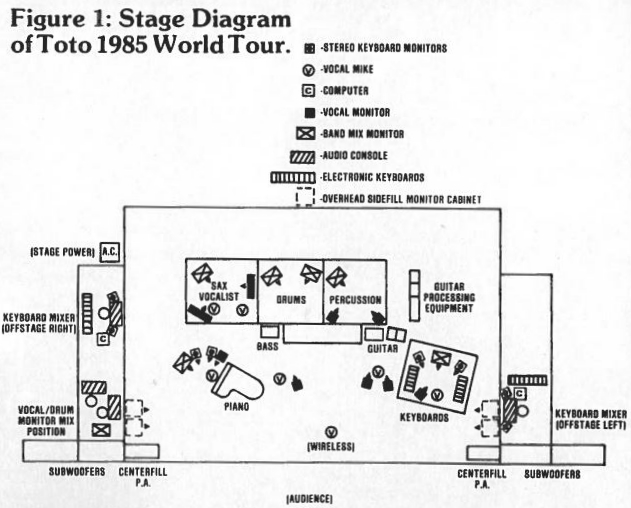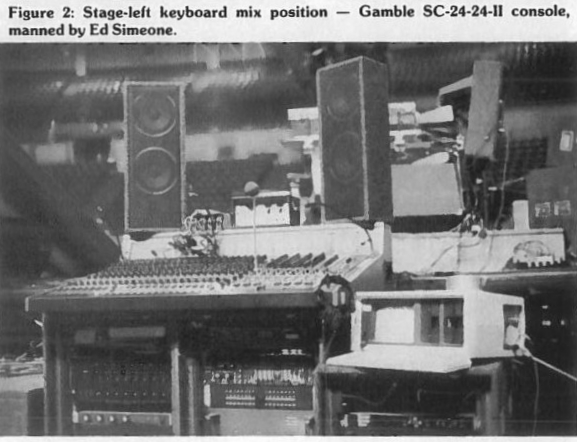From the August 1985 issue of the late, great Recording Engineer/Producer (RE/P) magazine, David Scheirman takes a look at the touring setup for the international tour of the legendary band, Toto.
Take one of the music world’s best-known, Grammy Award winning pop rock groups, a custom-tailored concert sound system, 136 stage inputs, computer controlled stage instrumentation, a new concept in monitoring, six (6!!) veteran live sound mixers, and several months’ worth of international touring . . . and the recipe exists for one of the most complex concert sound projects to be out on the road this year.
Starting in February of this year, The Toto Entourage kicked off its 1985 World Tour in Japan.
A complete stage-monitoring system, and a house mixing package equipped with a regulated power distribution system, were shipped to all international dates.
For the Japanese portion of the tour, a house reinforcement system was contracted through Hibino Sound. All North American dates were handled by Schubert Systems Group, of Gardena, CA.
On March 19, 1985, Toto’s U.S. tour began at the Arizona State University Activity Center in Tempe, Arizona. This writer journeyed to the site for a first-hand look at the group’s advanced audio system, which features multiple mixing consoles with six operators.
David Bowers, Dirk Schubert, and Ed Simeone
The Band
Toto is a notable group, comprised of some of America’s busiest working studio session musicians. The group’s albums have often featured innovative recording techniques and instrumentation. Collectively, members of Toto — David Paich, Steve Lukather, plus Jeff, Steve and Mike Porcaro — have probably participated in the playing, arranging and recording of more recent, American popular rock music than any other similar group of musician/technicians.
Several of the band members operate personal-use recording studios, which are stripped of gear when the group does one of its infrequent tours. Shep Lonsdale, a recording engineer and audio mixer who has collaborated with the group on such recent ventures as the film soundtrack for Dune, is involved in all aspects of Toto’s sound.
“Having been involved with the actual recording to Toto’s music in the studio gives me a much different perspective on doing the live shows than many concert mixers might have,” explains Lonsdale. “Traditionally, a gap has existed between live and recorded sound.”
“That gap is starting to narrow, as the technology becomes available to recreate the sound of an album in a live performance setting. Stage technology is improving, and concert-sound systems are now beginning to offer the fidelity that has been lacking in the past. The sound of the recorded music and the sound of the live show are important to the members of Toto.”
The Live Concept
Dirk Schubert, of Schubert Systems Group, was actively involved in assembling Toto’ s custom studio monitoring system and performance hardware. When the band chose SSG to provide full sound reinforcement services as well for the group’s live tour, Schubert went along as a monitor mix engineer.
“One of the most important things to understand here is that these guys know what they want,” states Schubert. “They craft their musical packages in the studio, and they are used to a certain way of hearing everything . . . stereo keyboard monitors, special vocal monitors, and instrument submixers. It was up to us to figure out how to take the whole thing on the road in an easily-transportable package.
“Our touring accounts get something that other sound companies are not often able to address: if the gear doesn’t exist to give them the sound or the operational functions that they want, we build it for them.”
To make Toto’s live show happen, 136 stage inputs were funneled down to house and stage monitor mixing positions, each with two Gamble consoles (and two board operators) by using separate, manned stereo keyboard submix positions (Figure l).
Hidden offstage, these two consoles gave both keyboardists David Paich and Steve Porcaro an individual audio mixer for submixing the multiple stage rigs (with banks of MIDI connected keyboards), as well as a “private” stage monitor man for each musician’s own musical program material. Personal computers assisted in the MIDI-switching of the two rigs.
The instrument submix for Steve Porcaro was handled by Ed Simeone, who gained a great deal of experience with complex keyboard setups during his several years of touring with Electric Light Orchestra.
Simeone mixed on a Gamble SC24-24-II board. Designed and built by Jim Gamble Associates, the transformerless console features 24 inputs and 24 outputs, and seemed to be ideally suited for use as a stage instrument mixer (Figure 2).
“Basically, what we are doing here is giving the musician access to a wide variety of electronic instrument voicings, and using MIDI-switching technology to keep the stage clutter to a minimum.” Simeone explains.


















